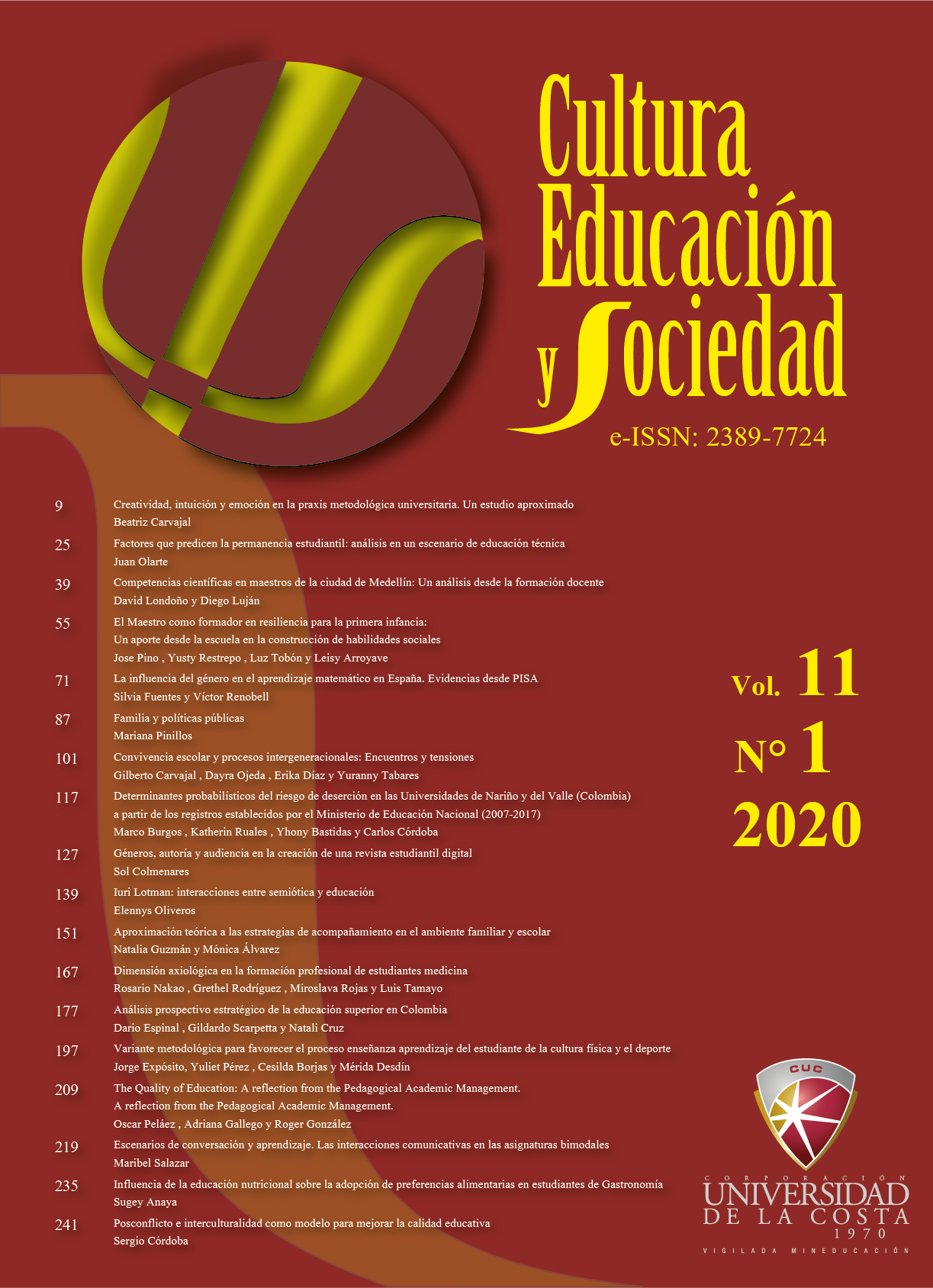Iuri Lotman: Interactions between semiotics and education
DOI:
https://doi.org/10.17981/cultedusoc.11.1.2020.10Keywords:
Semiotics, Semiosphere, EducationAbstract
The present reflection article has as purpose to expose the contributions and postulates of Iuri Lotman's semiotics. To this end, it first reviews the notion of semiotics and its interrelations with other fields of knowledge, as well as the elements of confluence between this discipline and the terminological borrowings it has received from areas such as chemistry and biology, to finally enter into the discussion of semiotics as a meta-science. Then, some of the postulates of Lotmanian semiotics are discussed, which are sustained in notions such as semiosphere, text, border and semiosis. The reflection concludes with the contributions of semiotics in education and the important role of the semiotic operations of attribution, substitution and overcoming to explain how during the process of teaching and learning the student interpreter-producer will identify new values thanks to the process of attribution and substitution of what he already knew.
Downloads
References
Blanco, D. (2006). Semiótica y Ciencias Humanas. Revista Letras, 77, 111–112. Recuperado de http://www.acuedi.org/ddata/3157.pdf
Castillo, M. (2017). ¿Semiótica en el estudio de la comunicación? Razón y palabra, 21(4_99), 34–44. Recuperado de https://www.revistarazonypalabra.org/index.php/ryp/article/view/1074
Cáceres, M. (1994). Lenguaje, cultura, semiosfera. En, J. Paz, J. Fernández y C. Gómez (cords.), Actas del V Congreso internacional de la Asociación Española de Semiótica, Semiótica y modernidad (pp. 129–136). Universidade da Coruña, Coruña. Recuperado de https://core.ac.uk/download/pdf/61903492.pdf
Eco, U. (1994). Signo. Barcelona: Labor.
García, Í. (2014). Pedagogía semiótica sensible en la práctica significante de la docencia. Ontosemiótica, 1(1), 77–86. Recuperado de http://erevistas.saber.ula.ve/index.php/ontosemiotica/article/view/5354
García, Í. (2012). Semiótica y didáctica. Relaciones pensamiento/semiosis/mundo en la construcción de aprendizajes significativos en el Aula Preescolar. Omnia, 18(2), 11–24. Disponible en https://produccioncientificaluz.org/index.php/omnia/article/view/7389
Lampis, M. (2015). La teoría semiótica de Lotman y la dimensión sistémica del texto y de la cultura. Revista Signa, 24, 393–404. https://doi.org/10.5944/signa.vol24.2015.14727
Lara-Escobelo, M., Rubio-Toledo, M. e Higuera-Zimbrón, A. (2011). Semiótica y arquitectura. Quivera, 13(1), 139–155. Disponible en https://quivera.uaemex.mx/article/view/10162
Lotman, I. (1996). La semiosfera I. Semiótica de la cultura y del texto. Madrid: Cátedra.
Lotman, I. (1998). La semiosfera II. Semiótica de la cultura, del texto, de la conducta y del espacio. Madrid: Cátedra.
Luque, M. y Marín, F. (2001). Inserción de los proyectos pedagógicos de aula en las prácticas profesionales de la docencia. Multiciencias, 1(2), 117–128.Disponible en http://produccioncientificaluz.org/index.php/multiciencias/article/view/16556
Magariños, J. (2008). La semiótica de los bordes. Apuntes de metodología semiótica. [Online]. Recuperado de http://www.magarinos.com.ar/Impresion.html
Magariños, J. (2007). La semiótica de los bordes. Tópicos de seminario, 2(18), 97–112. Disponible en http://www.topicosdelseminario.buap.mx/index.php/topsem/article/view/157
Mena, M. y Huneeus, M. (2017). Convivencia Escolar para el aprendizaje y buen trato de todos: Hacia una mejor comprensión del concepto. Cultura, Educación y Sociedad, 8(2), 9–20. https://doi.org/10.17981/cultedusoc.8.2.2017.01
Morris, Ch. (1985). Fundamentos de la teoría de los signos. Barcelona: Paidós.
Mounin, G. (1972). Claves para la lingüística. México, D.F.: Anagrama.
Richards, J., Platt, J. y Platt, H. (1997). Diccionario de lingüística aplicada y enseñanza de lenguas. Barcelona: Ariel.
Saussure, F. (1972). Curso de lingüística general. Buenos Aires: Losada.
Sebeok, T. (2005). ¿En qué sentido es el lenguaje un sistema modalizante primario? AdVersusS, 2(2). Disponible en http://www.adversus.org/indice/nro2/articulos/articulo2-Thomas%20Sebeok.htm
Simone, R. (2001). Fundamentos de lingüística. Barcelona: Ariel.
Vidales, C. (2011). Semiótica y teoría de la comunicación. Tomo II. Monterrey: CECYTE, N.L.-CAEIP.
Vidales, C. (2009). La relación entre la semiótica y los estudios de la comunicación: un diálogo por construir. Comunicación y Sociedad, (11), 37–71. Disponible en http://www.comunicacionysociedad.cucsh.udg.mx/index.php/comsoc/article/view/1793
Published
How to Cite
Issue
Section
License
Copyright (c) 2022 CULTURA EDUCACIÓN Y SOCIEDAD

This work is licensed under a Creative Commons Attribution-NonCommercial-NoDerivatives 4.0 International License.
![]()
Creative Commons 2020 CULTURA EDUCACIÓN Y SOCIEDAD
This article is under international license Creative Commons Reconocimiento-NoComercial-SinObrasDerivadas 4.0.
The published articles are the sole responsibility of their authors and do not necessarily reflect the opinions of the editorial committee.
CULTURA EDUCACIÓN Y SOCIEDAD respects the moral rights of its authors, who assign to the editorial committee the patrimonial rights of the published material. In turn, the authors inform that this work is unpublished and has not been previously published.
All articles are under a:
Licencia Creative Commons Atribución-NoComercial-SinDerivadas 4.0 Internacional.
![]()


 English
English
 Español (España)
Español (España)




_12.53_.27_p_. m_._3.png)





_12.57_.35_p_. m_._3.png)
_12.50_.37_p_. m_._3.png)



